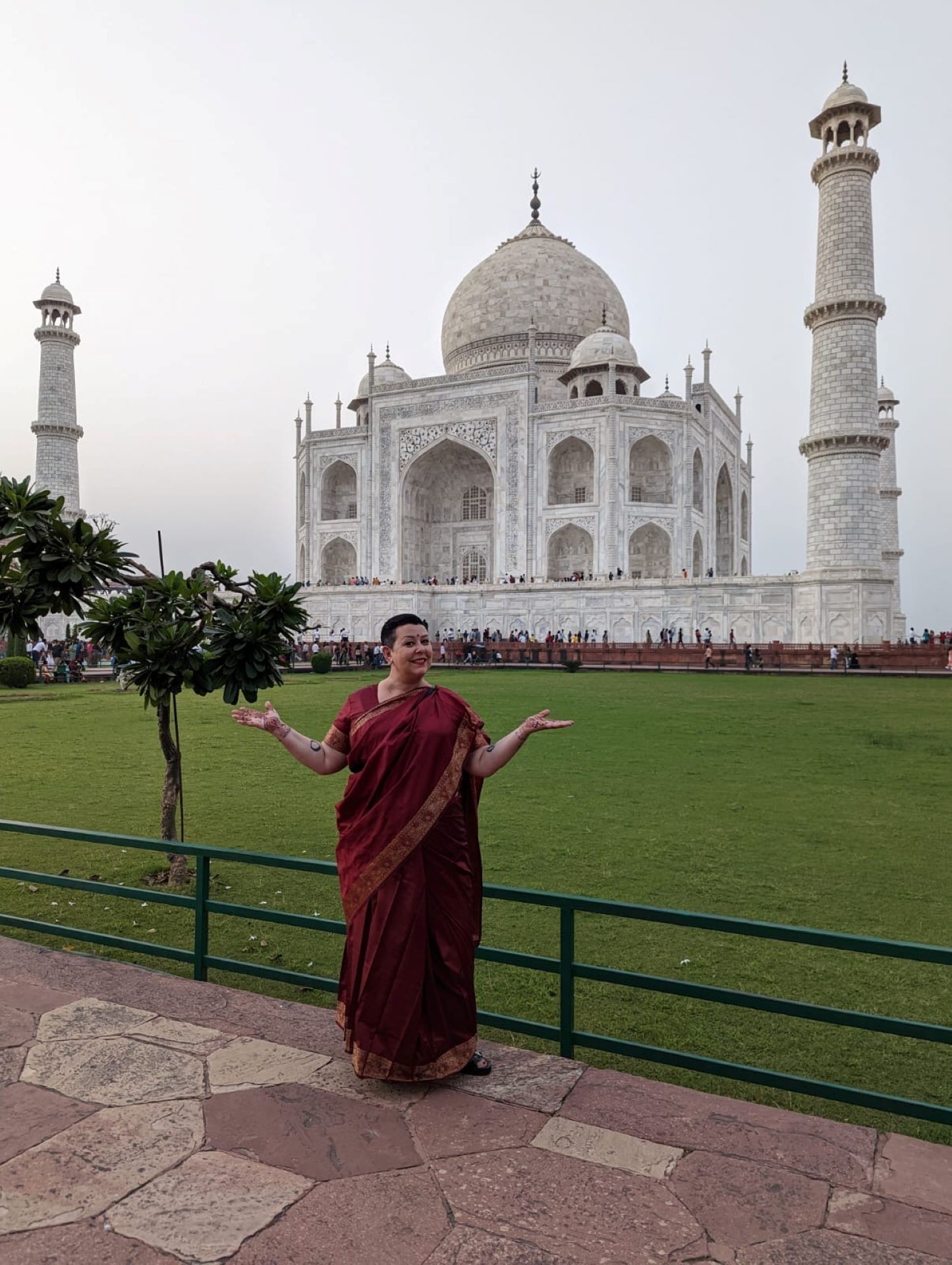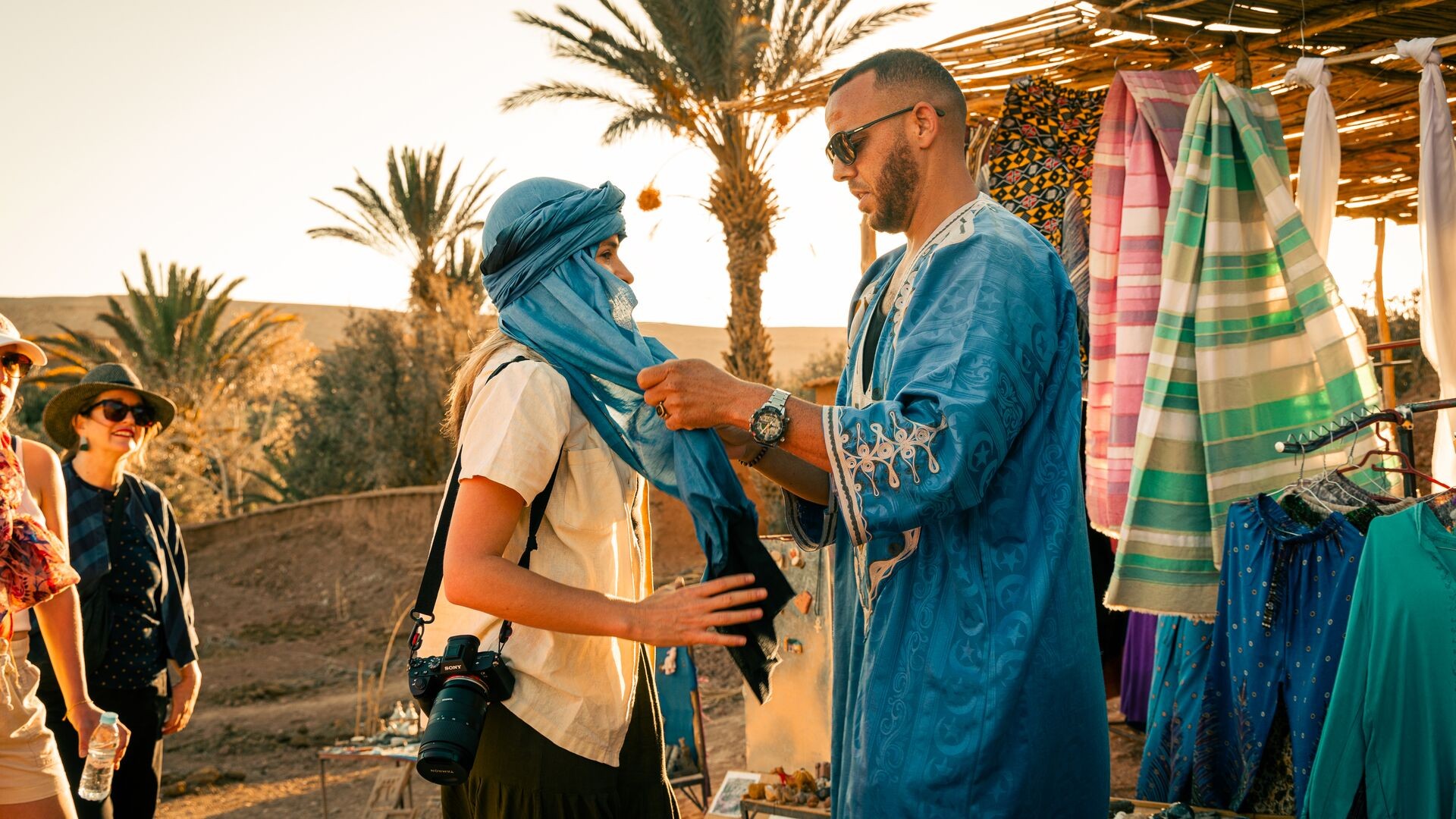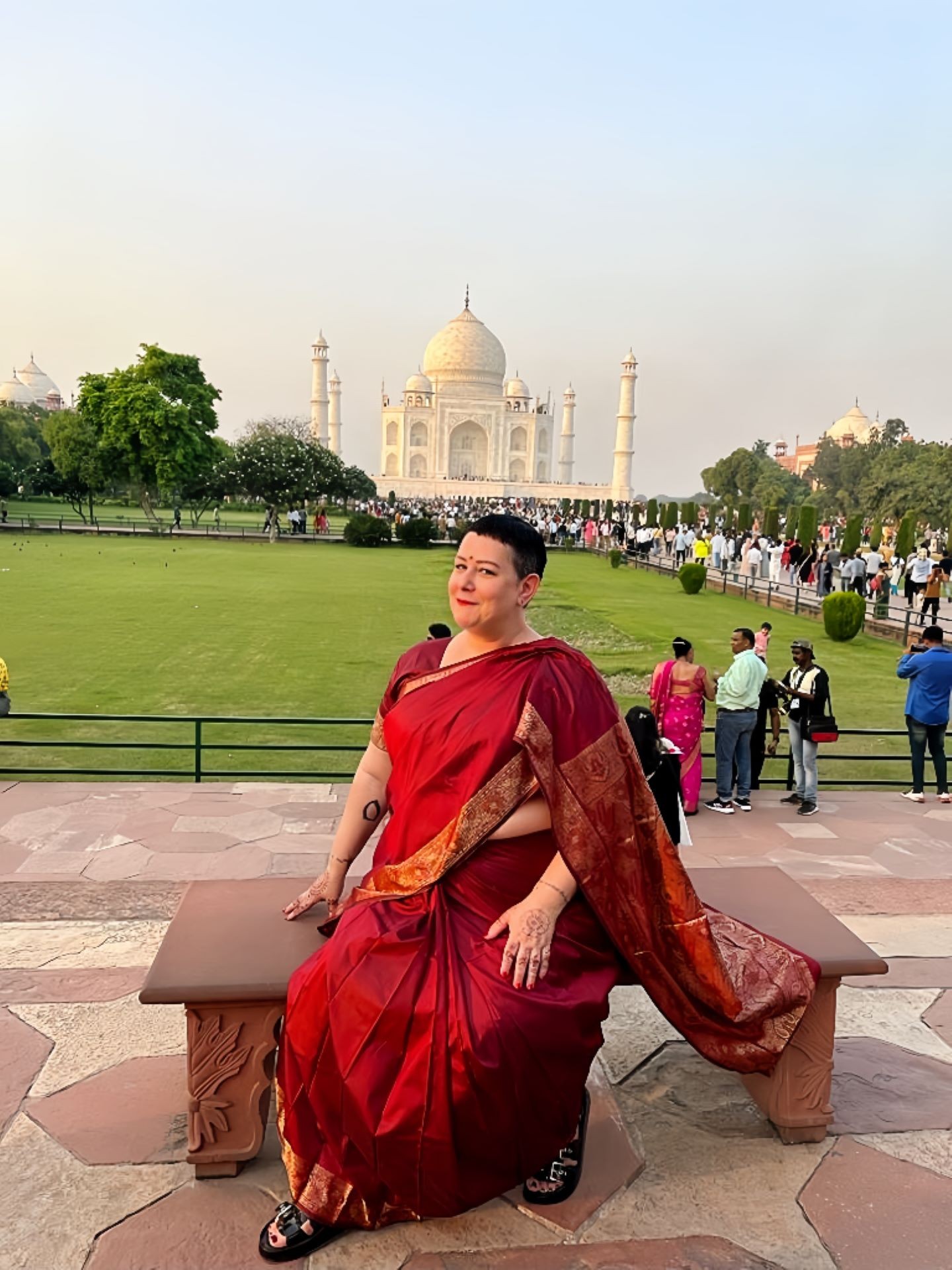Are you curious about experiencing Vietnamese culture firsthand by trying on traditional clothing? SIXT.VN helps you explore Vietnam with respect and understanding. Discover the do’s and don’ts of embracing local fashion and plan your culturally immersive adventure today. Let us help you plan your trip with tailored travel advice and reliable booking services.
1. Understanding the Allure of Traditional Vietnamese Clothing
Traditional Vietnamese clothing is not merely fabric and design; it’s a vibrant tapestry woven with history, culture, and profound symbolism. For centuries, garments like the Áo Dài and Áo Tứ Thân have served as visual representations of Vietnamese identity, reflecting the nation’s values, aesthetics, and social norms. For many visitors, donning such attire is a captivating way to connect with the local culture, express appreciation, and create lasting memories.
1.1. The Áo Dài: A National Symbol
The Áo Dài, Vietnam’s elegant and iconic national garment, holds a special place in the nation’s heart. This graceful tunic, worn over flowing pants, embodies the country’s grace, femininity, and resilience. Its origins can be traced back to the early 18th century, evolving through various designs and styles to become the celebrated attire we recognize today. The Áo Dài is not merely clothing; it’s a symbol of Vietnamese identity, worn with pride on special occasions, in schools, and even as everyday wear.
1.2. Áo Tứ Thân: A Glimpse into History
The Áo Tứ Thân, with its four-paneled design, offers a glimpse into Vietnam’s rich history. This traditional dress, primarily worn in northern Vietnam, reflects the country’s agricultural roots and the values of community and family. The four panels are said to represent the parents of the bride and groom, symbolizing unity and harmony. While less commonly seen in modern daily life, the Áo Tứ Thân remains a cherished part of cultural performances and traditional festivals.
1.3. Beyond the Garments: The Cultural Significance
Traditional Vietnamese clothing is deeply intertwined with the country’s cultural values and social etiquette. Each element, from the fabric to the cut and the embellishments, carries a specific meaning. For instance, colors and patterns can denote social status, marital status, or regional affiliation. Understanding these nuances is crucial for travelers who wish to engage respectfully with Vietnamese culture.
2. Is It Okay for Tourists to Wear Traditional Vietnamese Clothing?
Yes, generally, it is okay for tourists to wear traditional Vietnamese clothing, but it’s essential to do so with respect and awareness. Embracing local attire can be a wonderful way to immerse yourself in Vietnamese culture and show your appreciation. However, it’s important to be mindful of the context, occasion, and cultural sensitivities. Here’s what to consider:
2.1. Respectful Intentions
The most important factor is your intention. When wearing traditional Vietnamese clothing, do so with genuine interest and respect for the culture, to experience the culture to connect with the local culture more. Avoid treating the clothing as a costume or a novelty item.
2.2. Choosing the Right Occasion
Consider the appropriateness of wearing traditional clothing for different occasions. Wearing an Áo Dài to a temple or a formal event is generally well-received, as it demonstrates respect for the setting. However, wearing it in a casual or disrespectful context may be seen as insensitive.
2.3. Seeking Guidance
If you’re unsure about the etiquette, seek guidance from locals, tour guides, or cultural experts. They can provide valuable insights into the proper way to wear and present the clothing. You can contact us at SIXT.VN for further consultation. Address: 260 Cau Giay, Hanoi, Vietnam. Hotline/Whatsapp: +84 986 244 358. Website: SIXT.VN.
2.4. Avoiding Misrepresentation
Be mindful of how you present yourself while wearing traditional clothing. Avoid exaggerated or stereotypical portrayals, and refrain from making fun of the culture. The Vietnam National Administration of Tourism emphasizes that cultural exchange should always be conducted with dignity and respect.
2.5. Supporting Local Artisans
Consider purchasing traditional clothing from local artisans or businesses. This helps support the local economy and ensures that you’re acquiring authentic, well-made garments.
 Woman in Áo Dài in Hanoi
Woman in Áo Dài in Hanoi
A visitor respectfully wearing an Áo Dài in Hanoi, reflecting appreciation for Vietnamese culture
3. Guidelines for Trying on Traditional Vietnamese Clothing Respectfully
To ensure a positive and respectful experience when trying on traditional Vietnamese clothing, consider the following guidelines:
3.1. Research and Learn
Before your trip, take some time to research the history, significance, and etiquette associated with the garments you’re interested in wearing. Understanding the cultural context will help you appreciate the clothing on a deeper level.
3.2. Seek Permission and Guidance
If possible, seek permission and guidance from locals before trying on traditional clothing. Ask for advice on how to wear it properly and what occasions are appropriate.
3.3. Dress Appropriately
When wearing traditional clothing, ensure that you’re dressed appropriately for the occasion and setting. Avoid wearing revealing or inappropriate clothing underneath the garment.
3.4. Respectful Demeanor
Maintain a respectful demeanor while wearing traditional clothing. Avoid loud, boisterous behavior or actions that could be seen as disrespectful.
3.5. Avoid Cultural Appropriation
Be mindful of cultural appropriation, which involves adopting elements of a culture without understanding or respecting their original context. Avoid wearing traditional clothing in a way that trivializes or commodifies the culture.
3.6. Support Local Communities
Support local communities by purchasing traditional clothing from local artisans and businesses. This helps preserve traditional crafts and promotes sustainable tourism.
3.7. Share Your Experience
Share your experience of wearing traditional Vietnamese clothing with others, but do so with sensitivity and respect. Focus on what you learned and how it deepened your appreciation for the culture.
4. Common Types of Traditional Vietnamese Clothing and How to Wear Them
Here’s a detailed look at some common types of traditional Vietnamese clothing and guidelines on how to wear them respectfully:
4.1. Áo Dài
- Description: The Áo Dài is a long, elegant tunic dress worn over pants. It is typically made of silk or other fine fabrics and comes in various colors and designs.
- How to Wear:
- The Áo Dài should fit well, not too tight or too loose.
- Wear appropriate undergarments, typically a modest camisole and underwear.
- The pants should be the correct length, usually touching the top of your shoes.
- Maintain a graceful and respectful posture while wearing it.
- Occasions:
- Formal events such as weddings, festivals, and ceremonies
- Visiting temples or pagodas
- Cultural performances
- Some schools and workplaces require the Áo Dài as a uniform.
4.2. Áo Tứ Thân
- Description: The Áo Tứ Thân is a four-part dress traditionally worn in northern Vietnam. It includes a bodice, a long skirt, an outer tunic, and a belt.
- How to Wear:
- The bodice (yếm) is worn as an undergarment.
- The skirt (váy) is a long, flowing skirt that should reach the ankles.
- The tunic (áo tứ thân) is worn over the bodice and skirt, tied with a belt at the waist.
- The four panels of the tunic are often different colors, symbolizing the four parents.
- Occasions:
- Traditional festivals
- Folk performances
- Historical reenactments
- Cultural events
4.3. Áo Bà Ba
- Description: The Áo Bà Ba is a simple, casual outfit typically worn in southern Vietnam. It consists of a long-sleeved shirt and loose pants, usually made of cotton or silk.
- How to Wear:
- The shirt (áo bà ba) should fit comfortably and be buttoned up.
- The pants (quần) should be loose and comfortable, usually black or white.
- This outfit is often worn with a khăn rằn, a checkered scarf worn around the neck.
- Occasions:
- Daily wear, especially in rural areas
- Working in the fields
- Casual outings
- Folk performances
4.4. Khan Dong (Headwrap)
- Description: The Khan Dong is a traditional headwrap worn by men, often seen in traditional festivals and ceremonies.
- How to Wear:
- The Khan Dong should be wrapped neatly around the head, covering the hair.
- The style and color can vary depending on the region and occasion.
- Occasions:
- Traditional festivals
- Ceremonies
- Historical reenactments
- Cultural events
 Traveler in Vietnam
Traveler in Vietnam
A traveler learning to tie a traditional headscarf, demonstrating respect for local customs.
5. Etiquette Tips for Wearing Traditional Vietnamese Clothing in Public
Wearing traditional Vietnamese clothing in public is a wonderful way to show your appreciation for the culture. However, it’s essential to adhere to certain etiquette guidelines to ensure you’re doing so respectfully:
5.1. Be Mindful of the Setting
Consider the setting and occasion when wearing traditional clothing. Avoid wearing it in places or situations where it may be inappropriate or disrespectful, such as nightclubs or bars.
5.2. Avoid Exaggerated Gestures
Refrain from making exaggerated gestures or poses while wearing traditional clothing. Maintain a dignified and respectful demeanor at all times.
5.3. Show Respect to Elders
When interacting with elders while wearing traditional clothing, show extra respect by bowing slightly or using formal greetings.
5.4. Be Open to Questions
Be prepared to answer questions from locals about your choice to wear traditional clothing. Use these interactions as opportunities to learn and share your appreciation for the culture.
5.5. Respectful Photography
If you’re taking photos of yourself or others wearing traditional clothing, do so respectfully. Avoid staging photos that could be seen as mocking or trivializing the culture.
5.6. Avoid Wearing Fake or Inaccurate Attire
Ensure that the traditional clothing you’re wearing is authentic and accurate. Avoid wearing fake or inaccurate attire, as this can be seen as disrespectful.
5.7. Acknowledge and Appreciate
Acknowledge and appreciate the compliments and positive attention you receive while wearing traditional clothing. Express your gratitude to those who appreciate your efforts to engage with their culture.
6. Where to Find Authentic Traditional Vietnamese Clothing
If you’re interested in purchasing authentic traditional Vietnamese clothing, here are some recommended places to look:
6.1. Local Markets
Visit local markets in cities like Hanoi, Hoi An, and Ho Chi Minh City. These markets offer a wide variety of traditional clothing at reasonable prices. Be sure to bargain respectfully.
6.2. Tailor Shops
Consider visiting tailor shops, especially in Hoi An, which is famous for its skilled tailors. They can create custom-made Áo Dài and other traditional garments to your specifications.
6.3. Specialty Boutiques
Look for specialty boutiques that focus on traditional Vietnamese clothing. These stores often offer higher-quality garments and more unique designs.
6.4. Online Retailers
Explore online retailers that specialize in Vietnamese clothing and crafts. Be sure to check reviews and ensure the retailer is reputable.
6.5. Craft Villages
Visit craft villages that specialize in traditional weaving and embroidery. These villages often offer authentic, handcrafted garments directly from the artisans.
6.6. Ethical Considerations
When purchasing traditional clothing, consider the ethical implications. Support businesses that provide fair wages and safe working conditions for their employees.
7. Cultural Sensitivity and Avoiding Cultural Appropriation
Cultural sensitivity is crucial when engaging with any culture, including wearing traditional clothing. Cultural appropriation, on the other hand, is the adoption of elements of a minority culture by members of the dominant culture, often without understanding or respecting their original context. Here’s how to be culturally sensitive and avoid cultural appropriation:
7.1. Understand the Significance
Take the time to understand the significance of the clothing you’re wearing. Learn about its history, cultural context, and any specific meanings or symbolism it may carry.
7.2. Avoid Trivialization
Avoid wearing traditional clothing in a way that trivializes or commodifies the culture. Refrain from using it as a costume or a novelty item.
7.3. Respectful Representation
Present yourself respectfully while wearing traditional clothing. Avoid exaggerated gestures, poses, or behaviors that could be seen as mocking or disrespectful.
7.4. Seek Guidance
Seek guidance from locals or cultural experts if you’re unsure about the etiquette or appropriateness of wearing traditional clothing in a particular situation.
7.5. Support Local Communities
Support local communities by purchasing traditional clothing from local artisans and businesses. This helps preserve traditional crafts and promotes sustainable tourism.
7.6. Be Open to Learning
Be open to learning from your experiences and interactions with the local culture. Use these opportunities to deepen your understanding and appreciation.
7.7. Reflect on Your Motivations
Take time to reflect on your motivations for wearing traditional clothing. Ensure that your intentions are genuine and respectful.
 Vietnamese tailor at work
Vietnamese tailor at work
A skilled Vietnamese tailor crafting traditional clothing, preserving cultural heritage.
8. The Role of Tour Operators in Promoting Respectful Cultural Exchange
Tour operators like SIXT.VN play a crucial role in promoting respectful cultural exchange by educating travelers about local customs and etiquette. Here’s how we can help you:
8.1. Pre-Trip Education
We provide pre-trip information about Vietnamese culture, including guidelines for wearing traditional clothing respectfully.
8.2. Local Guides
We employ knowledgeable local guides who can offer insights into the history, significance, and etiquette associated with traditional garments.
8.3. Cultural Immersion Activities
We organize cultural immersion activities that allow travelers to interact with locals and learn about their traditions firsthand.
8.4. Ethical Tourism Practices
We promote ethical tourism practices, such as supporting local artisans and businesses.
8.5. Responsible Travel
We encourage responsible travel by reminding travelers to be mindful of their impact on the environment and local communities.
8.6. Feedback and Dialogue
We encourage feedback and dialogue about cultural exchange, creating opportunities for travelers and locals to learn from each other.
9. Benefits of Engaging Respectfully with Local Culture
Engaging respectfully with local culture offers numerous benefits for both travelers and the host community:
9.1. Deeper Cultural Understanding
It fosters a deeper understanding and appreciation of the local culture, history, and traditions.
9.2. Meaningful Connections
It creates opportunities for meaningful connections between travelers and locals, promoting cross-cultural understanding and friendship.
9.3. Positive Impact on Local Communities
It supports local economies and helps preserve traditional crafts and cultural heritage.
9.4. Enriched Travel Experiences
It enriches travel experiences, creating lasting memories and a greater sense of fulfillment.
9.5. Promotion of Tolerance and Respect
It promotes tolerance, respect, and mutual understanding between people of different cultures.
9.6. Sustainable Tourism
It contributes to sustainable tourism by encouraging responsible and ethical travel practices.
9.7. Personal Growth
It fosters personal growth and self-awareness by challenging travelers to step outside their comfort zones and engage with different perspectives.
10. Planning Your Trip to Vietnam with SIXT.VN
Planning a trip to Vietnam can be an exciting adventure, but it can also be overwhelming. SIXT.VN offers a range of services to make your trip seamless and enjoyable:
10.1. Tailored Travel Advice
We provide personalized travel advice based on your interests and preferences.
10.2. Airport Transfers
We offer reliable and convenient airport transfer services to ensure a smooth arrival and departure.
10.3. Hotel Booking
We can help you find the perfect accommodations to suit your budget and preferences.
10.4. Tour Bookings
We offer a variety of tours and excursions to help you explore Vietnam’s top attractions.
10.5. Flight Bookings
We can assist you with booking flights at competitive prices.
10.6. 24/7 Support
We provide 24/7 support to assist you with any questions or concerns during your trip.
10.7. Customized Itineraries
We can create customized itineraries to help you make the most of your time in Vietnam.
Conclusion:
Trying on traditional Vietnamese clothing can be a rewarding and enriching experience, provided you do so with respect, awareness, and a genuine interest in the local culture. By following the guidelines outlined in this article, you can ensure that your engagement with Vietnamese culture is positive and meaningful. With SIXT.VN, planning your trip to Vietnam is easier than ever. Contact us today to start planning your cultural adventure! Address: 260 Cau Giay, Hanoi, Vietnam. Hotline/Whatsapp: +84 986 244 358. Website: SIXT.VN.
Frequently Asked Questions (FAQs)
1. Is it disrespectful for tourists to wear Áo Dài?
No, it’s generally not disrespectful for tourists to wear Áo Dài if they do so with respect and appreciation for Vietnamese culture. Avoid treating it as a costume and be mindful of the occasion.
2. Where can I buy an authentic Áo Dài in Vietnam?
You can buy an authentic Áo Dài at local markets, tailor shops, specialty boutiques, and online retailers in Vietnam.
3. What is the appropriate way to wear an Áo Dài?
The Áo Dài should fit well, not too tight or too loose. Wear appropriate undergarments, and maintain a graceful posture.
4. Can I wear Áo Dài to a temple or pagoda?
Yes, wearing Áo Dài to a temple or pagoda is generally well-received as it demonstrates respect for the setting.
5. What is cultural appropriation, and how can I avoid it?
Cultural appropriation is adopting elements of a culture without understanding or respecting their original context. Avoid trivializing or commodifying the culture and support local communities.
6. Are there any specific occasions when I should not wear traditional Vietnamese clothing?
Avoid wearing traditional Vietnamese clothing in casual or disrespectful contexts, such as nightclubs or bars.
7. How can tour operators like SIXT.VN promote respectful cultural exchange?
Tour operators can provide pre-trip education, employ local guides, organize cultural immersion activities, and promote ethical tourism practices.
8. What are the benefits of engaging respectfully with local culture?
Engaging respectfully with local culture fosters deeper cultural understanding, meaningful connections, and positive impact on local communities.
9. Can SIXT.VN help me plan my trip to Vietnam?
Yes, SIXT.VN offers tailored travel advice, airport transfers, hotel booking, tour bookings, flight bookings, 24/7 support, and customized itineraries.
10. How can I contact SIXT.VN for travel assistance?
You can contact SIXT.VN at Address: 260 Cau Giay, Hanoi, Vietnam. Hotline/Whatsapp: +84 986 244 358. Website: SIXT.VN.
By understanding the nuances of Vietnamese culture and acting with respect, visitors can enjoy a fulfilling and meaningful experience while exploring the beauty and traditions of Vietnam.



